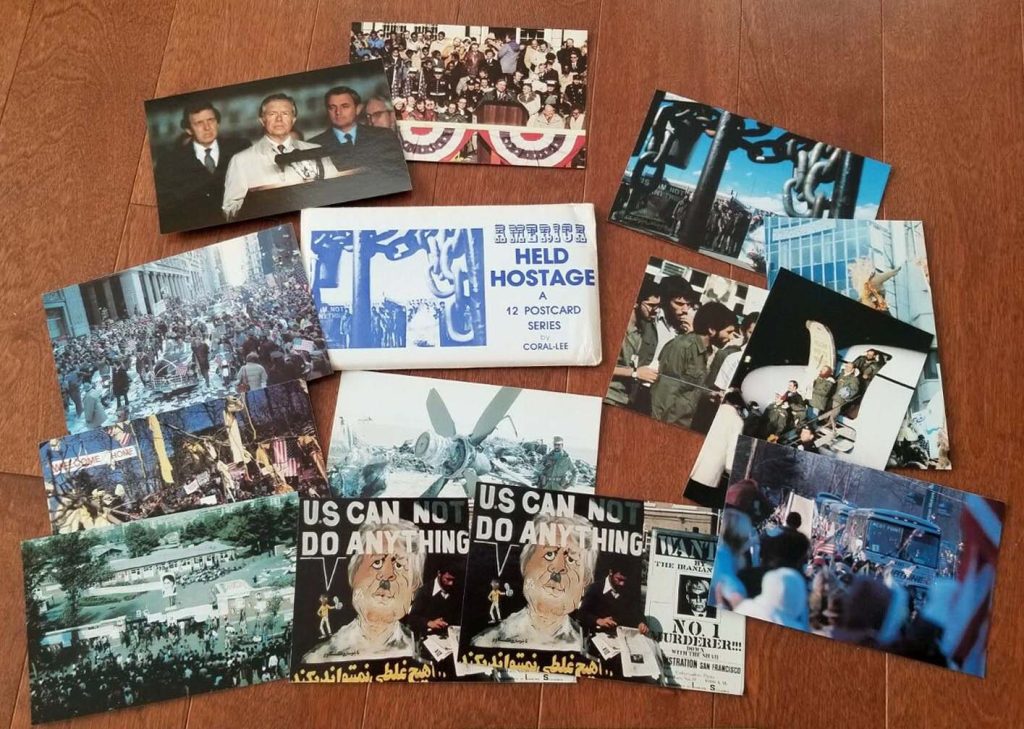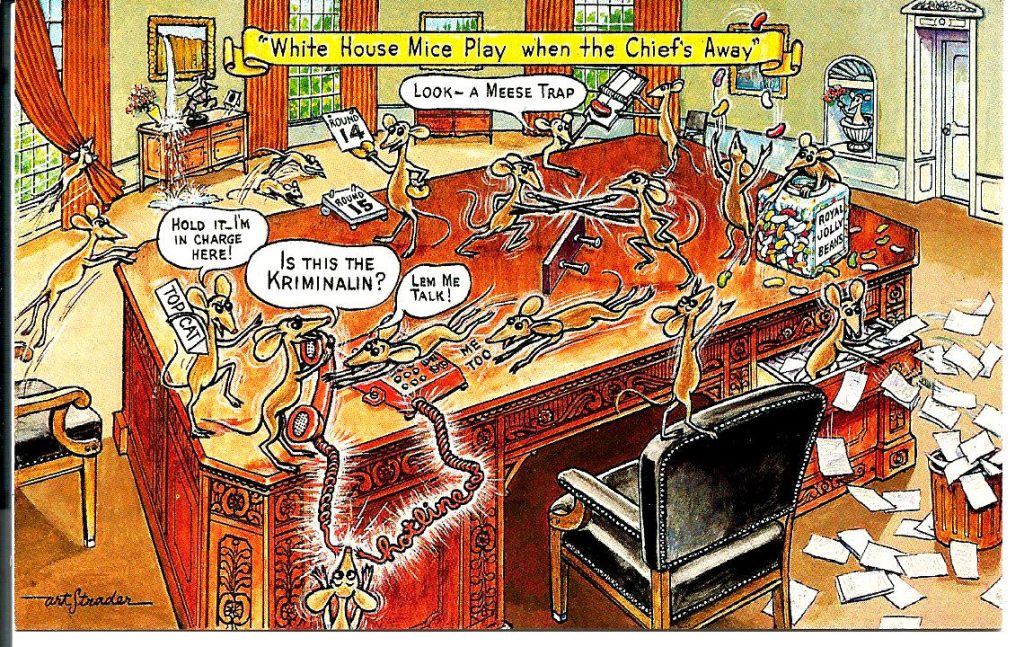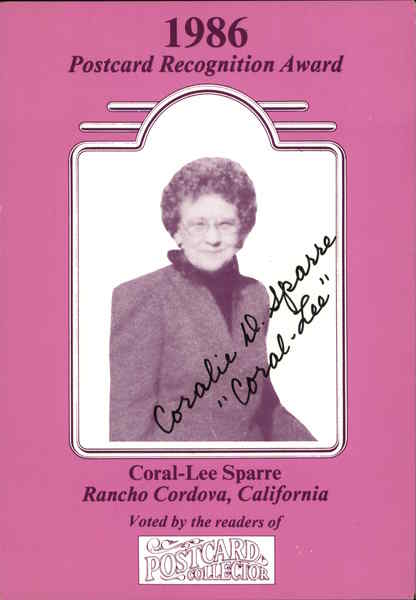Bill Burton
Coral-Lee
The First Lady of Postcard Publishing
In the November-December 1977 issue of American Postcard Journal, editor Roy Nuhn wrote a full-page article titled “Coral-Lee First Lady of Postcard Publishing.” The first two sentences sum up his admiration: “Out in California there is a wonderful energetic lady with so many ideas in her head that she’s revolutionizing modern day postcard publishing. Coralie Sparre, known to the hobby as Coral-Lee, is a retired school teacher who is anything but retired in her zest for life and in following her dream.”
Further, he wrote, “I believe she is not only the most important postcard publishing personality today but is likely to be one of the most important ever.”
Coral-Lee had collected postcards since the 1960s and had used them as visual aids in her teaching. When she retired in 1976, she decided that there was a need for postcards that documented the contemporary world.
Her first project was a series of cards on the Presidential administration of Jimmy Carter, who had just been elected. Her first project became a 12-card set, but by the time President Carter left office she had published 72 cards. She assembled all of them into an album that she personally presented to Carter in late January 1981 in the Oval Office. “And then, the photographer came in and took the picture.”
Of course she had the photograph made into a postcard. (She later said that the photo was supposed to be in color but that the photographer hadn’t done it.)

Once she had begun, Coral-Lee didn’t stop. This advertisement from the back cover of American Postcard Journal of September-October 1977 (repeated on the November-December 1977 issue) shows the proliferation of her ideas.
The ad shows that, in addition to “Inauguration Series” Series #1 and “Carter’s First 100 Days” Series #2 (both 12-card sets), she was selling individual cards not only of Carter and his family but also cards on Presidents Nixon (8-card series) and Ford (3 single cards of Ford, his wife Betty, and both with Carter on Ford’s last day in office).
But wait! There’s more!
She produced a single card of her printer, Mike Roberts, which she described as “the first in 30 years!”; 2 Bicentennial sets of 12 cards each; a 12-card set of “Personalities” that includes Linda Ronstadt, a very young Bruce Springsteen, and Carrie Fisher of Star Wars fame.
Even more, she was selling Jimmy Carter watches, on which he is pictured with a “large laughing face/peanut-man body.” A 1-jewel version was priced at $19.95 and a 17-jewel version for $29.95, plus $1 postage.
Roy Nuhn continued to boost Coral-Lee. He devoted the back cover of the combined November-December 1978/January-February 1979 issue to “The Latest from Coral-Lee.” He reports that “In the year since [his last article on Coral-Lee] she has continued unabated to issue superb sets and singles.”
Coral-Lee took a 2-page advertisement inside this issue. The first page recapped her earlier cards sets and singles, but she added a few hundred personally signed copies of the Mike Roberts card, describing it as “truly a collector card.” She also announced another watch, this one of Elvis Presley, “Love Me Tender, portrait and red hearts background.” “A good investment,” she said of this watch, which she, offered at $19.95 in a 1-jewel version.
Page 2 of the ad is her new series of Carter postcards, “Carter the President and Political Interest Post Cards,” numbers 27 through 37. Number 37 is titled “Ronald Reagan: With his favorite horse.” Also on the list is “Elvis: A 5 card set by Don Lancaster of Memphis, Tenn.” And finally she offers an assortment of “mint post cards of Mike Roberts … from all over the U. S. plus some scenes of England.” She priced these cards at $5 per hundred, minimum 100.

When Ronald Reagan defeated Carter the 1980 election, Coral-Lee hopped right in. She was born in Dixon, Illinois, Reagan’s hometown, and she explained that she knew “Ronnie” from those days. Her first Reagan-era postcard project was “America Held Hostage,” a 12-card set (note that she called it a series, which it really isn’t, since the number of cards is explicitly limited, in this case to 12, and were issued all at once).
In the four years that followed, Coral-Lee published hundreds of Reagan cards.
In Postcard Collector’s April 1984 issue, Dave Long (who wrote the column “Chrome Collecting”) said “It’s been suggested to me that Coral-Lee has published too many views and that their quality could be better! That’s a mater of personal opinion. I feel, but just for the record … I disagree! Some of the views picture less politically significant events than others, but they’re all collectible. And what’s more important is that all of the cards are currently available at a modest cost. A fair investment is needed to acquire all of these views, but I’ll guarantee you won’t be able to touch them for less than $3-4 once the available stock is depleted! That time probably isn’t very far away for some of the earlier views!”

By the time Long wrote, Coral-Lee had long expanded her horizons. She was publishing extensive lists of celebrities and baseball players but retained her interest in the Reagan White House, often publishing humorous cards.
In 1981, she complained to a columnist in the Sacramento Bee about not getting cooperation from the big names because they wanted too much money for their photos (“I can’t afford to pay royalties”), which explains why her baseball cards usually are of second-tier players.
In 1983 someone complained about her use of photos taken by the White House photographer. That became the subject of a memo from an in-house lawyer named John G. Roberts to the President’s Counsel Fred Fielding. Roberts wrote that the photos were officially in the public domain and Coral-Lee’s use of them was essentially like that of a newspaper.
By the end of the first Reagan administration in 1984, Coral-Lee was in full sail. She gave an interview to the Washington Post on December 30 that detailed how heavily she had invested in her venture.
“Coral-Lee . . . is sitting on 2½ million unsold post cards, most of them picturing President Ronald Reagan. Don’t laugh. She’s sunk her life savings — $50,000 — into those cards, and all in the hope of teaching America’s school children more about their presidents, but history seems not to sell. Few are snapping up Reagan on horseback with José Lopez Portillo.”
In that article, her Washington reseller says her best-seller was of Reagan with Vanessa Williams, and that of the 300-plus Reagan postcards she has made, only 92 have found a market in Washington.
“[Coral-Lee] is running out of money,” continued the article. “These days she despairs of completing the first Reagan term. ‘I get bitter sometimes that people think so little of their country. If only people realized what these [historical] postcards will mean to children if they bought all the cards and put them away. Today a postcard of Truman is worth $60. You know all the magazines and all the articles and all the newspapers aren’t going to be saved. If you have a 3 x 5 photo and a document on the back, well, put it on a postcard and it will live forever.’ ”
Coral-Lee persevered into 1985. On a postcard she responded to a collector that she was “going to Washington and NYC to gather the materials for the fourth year of the Reagan term.”
But the financial drain got to be too much. By the late 1980s she had accumulated so many unsold cards that the boxes were pushing her out of her house. She sold much of that inventory to dealers who to this day still have deep stock of her cards.

Coral-Lee wound down her publishing business by the late 1980s. In 1986
Postcard Collector’s readers voted her a special award and a postcard was printed and distributed to all of the magazine’s subscribers.
There are postcard publishers who have come and gone in less time than Coral-Lee was active. Coral-Lee cards are distinguished by the high quality of the photographs and printing. She sought out photographers of subjects she wanted to make into postcards, travelling from California to the East Coast to find “just the right picture.” Perhaps in today’s overwhelming information world we are too close to events to appreciate just how chancy documenting the world around us can be and just how financially risky it is to try.

I remember seeing many of Coralie’s cards for sale, but don’t think I ever bought any, as I prefer cards that weren’t made (at least exclusively) to be collectors’ items.
Great work, I’m glad to finally read some more about Coralie’s history. I only came by her postcards from the baseball angle, and her not wanting to pay licensing explains a lot. Sort of too bad she got lost down the rabbit hole of trying to write the history of Ronald Reagan’s first term one postcard at a time. As a teacher one would think she would have realized that postcards are not the way one writes an in-depth history of a subject. Books exist.
I didn’t have any room for delving into Coral-Lee’s sports card sidetrack. Why she went there I don’t know, nor do I fathom why she got into movie stars. It could be that she wasn’t getting much feedback from the Carter-Reagan cards.
So much of what we’re able to see of the past, through the medium of the postcard, depends on the fact that, long ago, a great many photographers and publishers made the questionable business decision to get into postcards. This is evident from the brief careers of many RPPC photographers and lithographed postcard publishers. Coralie must have been one of the last of that enterprising breed.